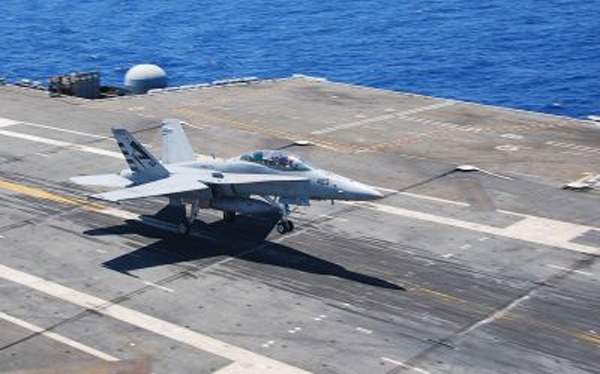A U.S. Navy F/A-18D surrogate aircraft emulated an autonomous, unmanned aircraft as it performed several approaches to arrested landings on the deck of the USS Dwight D. Eisenhower (CVN-69) on 2 July.
The carrier landing test included the use of new Precision GPS and Tactical Targeting Network Technology (TTNT), which is being developed for the Navy’s Unmanned Combat Air System Carrier Demonstration (UCAS-D) Programme. The Precision GPS and TTNT, intended to provide guidance and control, is being developed by an industry team working with the Navy.
The full test spanned 10 days of flights, between June 27 and July 6, and employed the F/A-18 and a King Air surrogate aircraft. During that time, the test logged more than 42 flight hours in the F/A-18 and King Air surrogates, as well as 64 successful approaches using two different approach profiles with the UCAS-D system.
Three operators on board the Eisenhower during the 10-day UCAS-D surrogate aircraft test–serving as CATCC controller, Air Boss, and Landing Signal Officer (LSO)–are engineers at ARINC Inc., headquartered in Annapolis, Md. Other ARINC personnel served as: Aviation/Ship Integration (A/SI) Test Lead on the ship, Beach Detachment Lead ashore, and PGPS Lead ashore.
Eighteen professionals from ARINC Inc. in Annapolis, Md., are working on the UCAS-D aviation/ship integration effort, serving as team leads, engineers, configuration managers, risk managers, and subject matter experts. Their role is to help ensure Navy requirements are properly developed, documented, understood, and implemented.
“It was truly great to see the UCAS-D approaches and landings. They came in straight, as if they were on rails, with minimal if any perceived deviations from their glideslope or course,” says ARINC Staff Principal Engineer Marty Paulaitis, who worked the LSO platform. “The other LSOs who were watching just turned to me and said ‘Wow!’”
The successful landing and launching of the surrogate unmanned aircraft “allows us to look forward to demonstrating that a tailless, strike-fighter-sized, unmanned system can operate safely in the carrier environment,” says Captain Jaime Engdahl, Navy UCAS programme manager.
UCAS-D technology will take the place of traditional UHF voice communications currently used by the Carrier Air Traffic Control Center (CATCC), Air Boss in the tower, and Landing Signal Officer (LSO) to control unmanned carrier aircraft.
“When integrated into aircraft carriers, technologies developed by the UCAS-D programme have the potential to provide the digital solutions and precision guidance through all phases of flight to enable future unmanned combat aircraft to operate seamlessly with manned aircraft within the Carrier Control Area (CCA) of 50nm from the carrier,” according to a spokesperson.
In addition to guidance and control technology for the aircraft, the UCAS-D programme requires the upgrade and integration of six existing command-and-control systems on board the carrier, and development and integration of three new cutting-edge technology systems.
Source: Military & Aerospace Electronics

